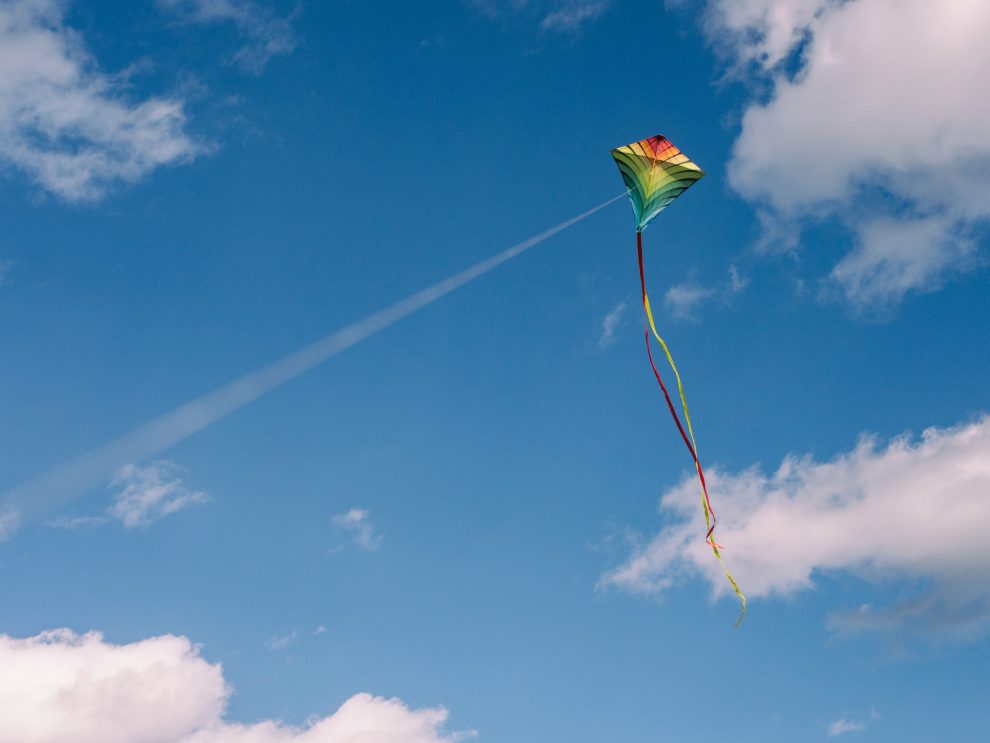Kite-flying is a venerable spring tradition, but in our family it also has religious significance. Every Easter, after the last egg is found and church clothes are hung, our family gathers kites, tails, and string and heads to the nearest open field. Living in the Midwest, this can mean skipping in light jackets or tromping through leftover snow in bundled layers to keep chilly blasts from rattling our bones. Either way, it marks an official, if sometimes defiant, welcome to spring’s promises of new life.
There is an almost palpable hope as each family member prepares to launch a kite. In fact, I have found kite flying parallels Good Friday’s anticipation of Jesus’ victory over death. I’m not alone. For more than a century the people of Bermuda have made kite flying their Good Friday tradition. Island lore has it that a Sunday school teacher or missionary illustrated Christ’s Ascension by flying a kite then cutting its string so it disappeared into the sky. Christians in Barbados, Greece, and other European countries observe similar customs on Easter Monday.
While kite flying is a good illustration of the Ascension, I see similarities between the act of flying a kite and our human and spiritual journey toward resurrection. It also resembles our hope and desire to be caught by God’s love and lifted to heights unimaginable.
Anyone who’s flown a kite knows they don’t typically go up in a straight line. They meander left and right and even in loops. The spiritual journey can feel like this. There are times when I become complacent. I think I have mastered the angles and it becomes blasé. The kite, or my faith walk, continues but lacks heart. Things can fall because I am not paying attention.
Catching the wind is tricky business, an exercise in faith. The force of a gentle breeze or strong blast cannot be seen. The outstretched flag or swaying trees prove that the wind exists because they have been touched. It reminds me that we are called to give proof of God’s existence.
Sometimes the wind, without warning, seems to disappear completely, and the kite falls. Quick tugs on the string may reconnect it to the wind. Other times a full-scale sprint in the opposite direction is necessary. Sometimes nothing can be done to alter the course. It can be frustrating.
The wind, like God’s presence, can seem to be everywhere except where I am. Others seem to be sailing along effortlessly. These are times I must return to the beginning. I need to check my position, angle, speed, then wait again at the taut-string stage. When the kite returns to the air, I’m filled with wonder and hope.
Kite-flying can also be a metaphor of the need for community. Releasing a kite can be done solo but is easier with another’s help. Even as the string is stretched taut between the one who will gently toss the kite into the wind and the one holding the reel, excitement seems to travel down the line. It’s play, but everyone sees the benefits of bearing one another’s burdens.
When our children were younger, my husband and I purchased a kite that resembled a package of rainbow-colored crayons. The kite was quick to get airborne and became a springboard for talking about Jesus’ Resurrection, Ascension, and the Holy Spirit’s rainbow gifts. The lack of a rigid frame meant it didn’t break when landing.
Over the years we have added kites to our collection. Some were fancy and colorful, multilayered contraptions that would have been incredible spectacles if we could only get them into the sky. Others were fragile and tore if the wind was too strong.
Last year our family decided to check out the new-fangled and very fast stunt kites. The shop owner wowed our now young adult children with the kites’ tricks and gave instructions for proper handling.
But on Easter we struggled with the powerful kites. They crashed with incredible force and frequency. Before long someone retrieved the old crayon kite from the trunk. Although it didn’t do the tricks the stunt kites promised, it did go up, reminding us of the importance of simplicity.
Our desire to rise above our human tendency to fall only needs God to allow us to soar on our journey to new life.
This article appeared in the March 2006 issue of U.S. Catholic (Vol. 71, No. 3, page 48).
Photo by Aaron Burden on Unsplash













Add comment